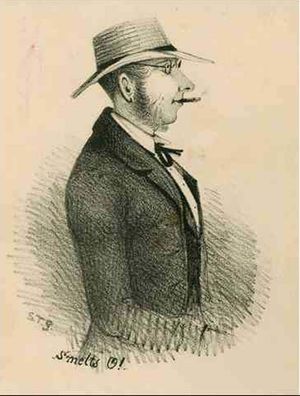Difference between revisions of "John Brown"
WikiadminBot (talk | contribs) (Bot: Automated import of articles *** existing text overwritten ***) |
WikiadminBot (talk | contribs) (Bot: Automated import of articles *** existing text overwritten ***) |
||
| Line 1: | Line 1: | ||
| − | |||
{{Infobox rai-fellow | {{Infobox rai-fellow | ||
| first_name = John | | first_name = John | ||
Revision as of 10:40, 28 May 2020
| John Brown | |||||||||
|---|---|---|---|---|---|---|---|---|---|
 | |||||||||
| Born | 1801 | ||||||||
| Died | 1879 | ||||||||
| Residence | Australia [APS] | ||||||||
| |||||||||
Contents
Notes
Office Notes
House Notes
Notes From Elsewhere
geographer?
??John Brown (1801?-1879), emigration agent and company manager, was the son of Samuel Brown and his wife Maria Josepha, daughter of the Nonconformist divine Robert Robinson, and a relation of George Augustus Robinson. He attended Mill Hill School from 1812 to 1815 and in 1833 was an importer of wines and spirits at St Mary at Hill, with his name registered as a voter in the city of London. Next year, on the failure of his business, he joined the South Australian colonizing movement. With Rev. Thomas Binney of Weigh House Chapel and with Rev. Barzillai Quaife he was associated in separate plans for providing the new colony with religious instruction on Dissenting principles. His understanding of the principles of systematic colonization was also singularly clear; he offered £250 to help the South Australian Association to continue, reported with R. D. Hanson on land for the Colonization Commission and assisted Edward Gibbon Wakefield to prepare evidence for the select committee on the disposal of colonial waste lands.
In seeking appointment as official emigration agent in the colony, Brown had to face the opposition of Colonel Robert Torrens, but was supported by Sir Moses Montefiore, by George Fife Angas who bought land orders worth £2000 to ensure his appointment, and by Fowell Buxton M.P. who wanted him to be protector of Aborigines as well. With others Brown signed the guarantee to enable the colony to be founded, but Torrens did not relent until June 1836. Brown sailed in the Africaine and arrived in the colony in November. Next year he figured prominently in disputes over the separation of powers in the South Australian Act. He had been appointed by the colonization commissioners and was therefore subject to their orders, not to those of the governor. When in September 1837 (Sir) John Hindmarsh suspended him from office for alleged neglect of duty, the resident commissioner, (Sir) James Fisher, promptly issued a printed handbill that Brown was still the official emigration agent. Hindmarsh replied with a proclamation appointing Y. B. Hutchinson in Brown's place. The question was referred to London and, after Governor George Gawler's arrival in October 1838, Brown was reinstated. He resigned within a year and with Charles Mann edited the Southern Australian, having signed the manifesto on 31 July 1837 proposing its foundation.
In October 1840 Brown was elected to Adelaide's first Municipal Council. Five years later, he became a director of the South Australian Mining Association after buying seventy-five of the original £5 shares in the Burra mine. In 1846 during the struggle against state aid to churches, he was elected a secretary of the League for the Preservation of Religious Freedom, and undertook to collect signatures for a petition to the Queen. Later he joined other leading voluntaryists in opening the short lived South Australian High School as a rival to the Collegiate School of St Peter. Thereafter he withdrew from public affairs to devote himself to the Adelaide Life Association and Guarantee Co., which he managed for more than thirty years. He died at Gilbert Street, Adelaide, on 17 August 1879. He had married twice but left no children.
From 11 February 1834 to 3 July 1836 Brown kept a diary which is now one of the best sources of information on the successful struggle to colonize South Australia. His shrewd criticisms and revealing comments show him as a penetrating observer of men and events. The diary and many of his papers are in the Mitchell Library. His portrait is in the National Gallery of South Australia.